This was published 5 months ago
‘Are we playing God?’ Researchers fast-track evolution in fight to save the reef
Australian scientists are getting ready for the world’s biggest reef intervention next year – the dispersal of millions of baby corals. Will this be enough to save it?
By Melissa Fyfe
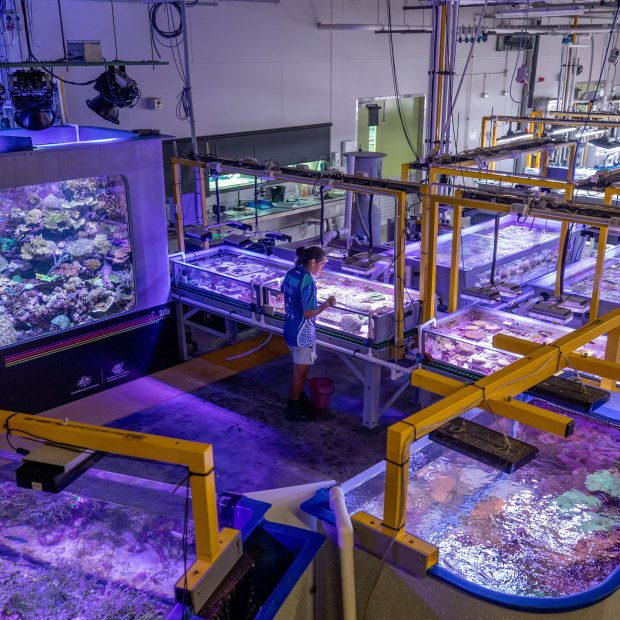
The National Sea Simulator near Townsville, in which climatic conditions can be manipulated to aid coral research.Credit: © Roslyn Budd
It’s not every day you get to snorkel with a Formula 1 driver. I use the word “with” here in a broad sense. It’s not just me and McLaren’s young rising star, Oscar Piastri, drifting over a Whitsundays reef, pointing out undersea wonders to each other. It’s a bunch of us: reporters, McLaren employees and Great Barrier Reef Foundation staff. It’s a special moment for Melbourne-born Piastri, 23, because he’s never seen the reef. But no one’s quite sure what it will be like today. It’s late March and the World Heritage Area is bleaching for the fifth time since 2016. We tilt our masks to the water and hope for the best.
Amid the greens and browns, and the odd blue and yellow, we see white. Not large fields of bleached coral, just singular ones, here and there. Afterwards, standing on shore in his orange McLaren polo top, Piastri reflects on what he’s witnessed. “I definitely saw some bleached coral and unfortunately some dead coral as well, so for me it highlights why it’s so important that we’re involved in this initiative.” The “initiative” is the reason we’re here on Queensland’s Hayman Island. McLaren is announcing that some of its best engineers will help automate the dispersal of millions of baby corals to try to support the reef through the ravages of climate change.
If you think coral and motor sport make strange bedfellows, you’re not alone. F1 cars pollute, of course, but the sport’s biggest carbon footprint comes from globetrotting their cars and teams to 21 nations each season. McLaren and F1 have set net zero emissions targets, yet the media launch seemed ripe with greenwashing potential. McLaren was no doubt delighted with the pictures of Piastri on the beach and the resulting news reports that cast the team as joining the fight to “help save the reef”. Money can’t buy that kind of publicity.
But here’s the thing. Few of the scientists and engineers involved in managing the reef in a warming world view McLaren’s involvement cynically. With almost half the reef experiencing unprecedented heat stress last summer, these experts – part of a collaboration that includes the Australian Institute of Marine Science, Great Barrier Reef Foundation (GBRF), CSIRO and four universities – have a task so challenging and urgent, they welcome all comers. Already, this largely taxpayer-funded partnership, called the Reef Restoration and Adaptation Program (RRAP), has spent $167 million since 2018 on research and development. In the next few years, for a further $50 million, it will roll out the world’s biggest reef intervention, creating several million corals, half of them more heat-tolerant types. If McLaren engineers can help solve bottlenecks on the baby coral production line, then great.
‘This is not a get-out-of-jail-free card to not act on climate change.’
Coral reef scientist Dr Line Bay
“There are experts from a range of fields around the world who may be able to help us deliver bigger solutions at smaller costs,” says coral reef scientist Dr Line (pronounced Lee-nah) Bay, research program director at the Australian Institute of Marine Science (AIMS) and a RRAP research leader.
But these attempts to help the reef adapt – from making so-called “super corals” in the laboratory to cloud brightening (yes, it’s a thing) – have their critics, most notably leading Australian reef expert Professor Terry Hughes, who say they are costly, impractical and a distraction from the core need for rapid carbon cuts. “We’re not naive,” says Bay, in response to this sort of criticism. “This is not a silver bullet. This is not a get-out-of-jail-free card to not act on climate change. There’s going to be a hard limit [to which] you can push coral. But I’m not willing to give up and throw my hands in the air and say nothing can be done without the data backing that up. As scientists for the Australian population, we’ve got to do the very best we can.”
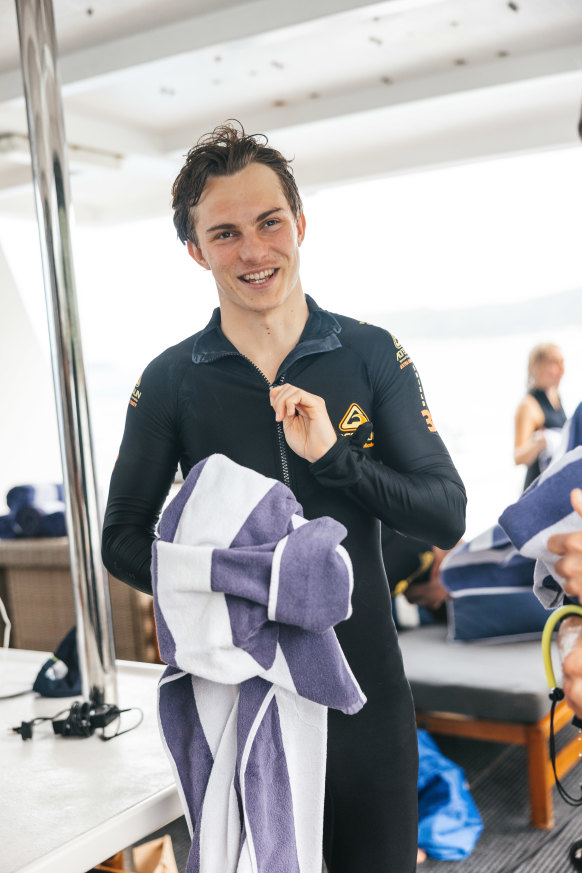
F1 driver Oscar Piastri on a McLaren media day, when the company spruiked its involvement in reef seeding.
At the National Sea Simulator (NSS), an hour’s drive south of Townsville, there’s a room that’s like a time machine for corals. Part of AIMS, it’s a huge research facility full of seawater tanks where a lot of the critical RRAP research is conducted. When I visit in late May, the institute’s technicians have so accurately mimicked the wild conditions of a reef off Townsville – the fading sunlight, the rising moonlight, the gloom in between – that the corals believe they’re living five months in the future. More precisely: they understand it to be the night after the full moon this coming October, at about 8.28pm, when actually it’s 3.28pm on May 24. The researchers have become so adept at time-tricking the corals, they can make them spawn in the early afternoon so workers can leave the office by 6pm.
But it does require a totally sealed-off room with a foyer of black curtains to ensure no daylight leaks in when the corals think it’s evening. This is why I’m in the dark, leaning over a tank with Loni Koukoumaftsis, a tall and warmly enthusiastic marine scientist, wearing a headlamp that throws a low-level red light onto browny-orange plate coral. It’s in what Koukoumaftsis calls the setting phase, or what I’m thinking of as the “pimple” stage. Small, whitish bumps are forming on the surface as the polyps, the animal part of the coral, get ready to burp out a package of eggs and sperm. Corals are colonies made up of thousands of polyps that are like tiny sea anemones. They’re animals that mostly consist of only a stomach, a mouth and tentacles that sprout at night to help them feed. But the bulk of their nutrients come from a plant, an algae, that cohabitates in their cells in a normally happy marriage. Under heat stress, the polyp will evict the algae – leaving it white or bleached – and eventually die of starvation if the heat doesn’t abate.
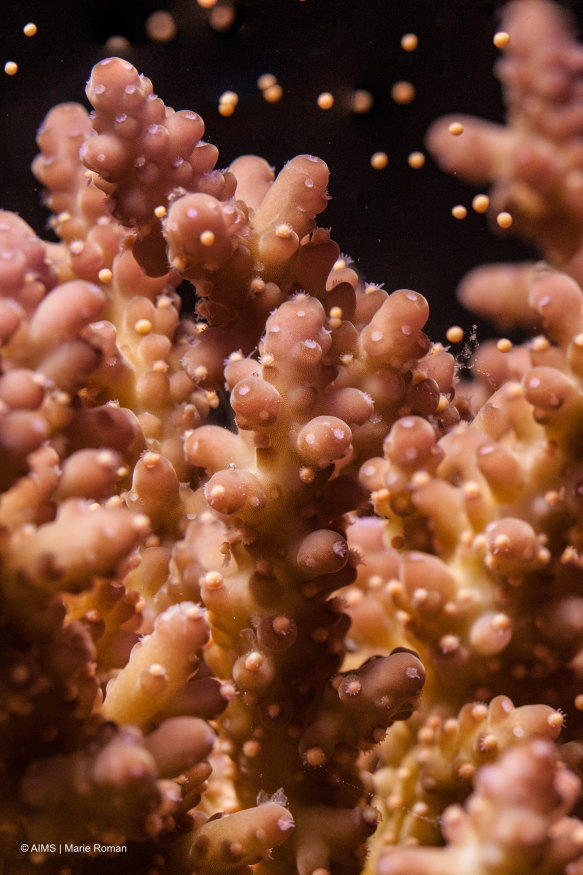
Coral spawning at the National Sea Simulator.Credit: © AIMS | Marie Roman
A little while later, we return to see these corals release a few dozen one-millimetre bundles of egg and sperm, the size of a sugar grain. They rise, as if in slow motion, to the surface. There aren’t many today, so Koukoumaftsis is under no pressure to collect them. But normally, he’d proceed with some coral IVF, pouring the mixture through a mesh screen to break up the bundles (in the wild, currents and waves do this). Then he’d swish the separated eggs and sperm in a plastic bowl until they fertilise, which takes about 30 minutes. In another room, Koukoumaftsis shows me the results of this process: a few days on, a bunch of little larvae are swimming around in a culture tank, looking for a place to settle and start a new colony.
It’s only the third year that Koukoumaftsis and colleagues have managed to create an out-of-season spawning (they first cracked it in 2022). Doing this means they don’t have to wait for the summer spawning and can provide more coral larvae for the institute’s experiments. “It’s been super-exciting to fast-track our understanding of young corals so we can support more reef restoration research,” he says.
To understand the task ahead for the RRAP scientists, it’s important to know how climate change is already affecting the reef. This is not an easy thing, partly because the reef, the world’s largest, is bigger than Italy and made up of nearly 3800 individual reefs that are impacted in different ways at different times. It is also deeply political because the reef is a proxy in the climate change wars. One side rings the doomsday bells, while the other insists everything’s fine. The reality is somewhere in between – and rather intriguing.
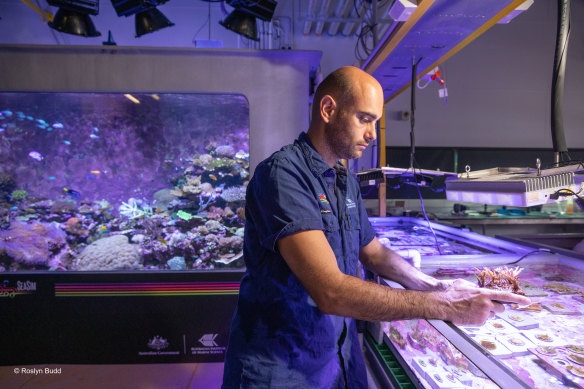
Loni Koukoumaftsis calls the research “super exciting”.Credit: © Roslyn Budd
In the past 15 years, the reef plunged to its lowest ever coverage of hard corals since surveys began 38 years ago. (Hard-coral cover is used as a reef health measurement because it’s the critical habitat underpinning the survival of thousands of other species of marine life.) Now, it’s at its highest in the central and northern regions after a remarkable reseeding of corals that has surprised reef scientists. “People who say all the corals are dead, that’s garbage,” says coral reef scientist Dr David Wachenfeld, who heads AIMS’ reef monitoring project. “But equally, people who say there’s more coral than ever before – and therefore no climate change – that is also garbage.”
To get a picture of what’s been going on, we need to travel to the reef’s north at Lizard Island, which Wachenfeld describes as “a beautiful miniature version of the story of the entire Great Barrier Reef”. Marine scientist Dr Anne Hoggett and her husband, Dr Lyle Vail, have run the Australian Museum’s Lizard Island Research Station for 34 years. Hoggett explains the island was spared the reef’s first mass bleaching in 1998. Bleaching came, though, in 2002 and 2010. In 2014 and 2015, the island was hit with two category-four cyclones, which stripped the corals to bare rock around the edge of the Lizard Island group but spared those in the lagoon. Then came what Hoggett describes as the “catastrophic” bleaching of 2016, which wiped out the lagoon corals. Only a small suite of tough coral species survived. In 2017, the temperatures matched 2016, but there was nothing much left to kill. “And there was hardly any spawning because most of the adult corals were dead.”
At this point, you might be getting a little depressed about Lizard Island. But something remarkable happened. One year later, Hoggett noticed the corals growing again. Recovery was by no means everywhere, “but in some places, the corals had grown to such an extent that the reef looked absolutely fabulous again by the end of 2023. It was just incredible.”
This plunge and surge of coral growth on Lizard Island and elsewhere across the reef is so unexpected that reef scientists have been trying to work out what’s going on. Scientists such as Hoggett noticed that some of the new growth came from tiny corals that had settled before the bleaching, survived the heat and replaced the dead adults. It’s also thought that coral larvae drifting in the water column – where they can potentially live for weeks and travel tens of kilometres – settled and repopulated the vacant space. The problem, says Hoggett, is that the recovery depends on larvae from other reefs. “As the years go on, there are going to be fewer places to provide the larvae to reseed these damaged areas. It won’t bounce back forever.”
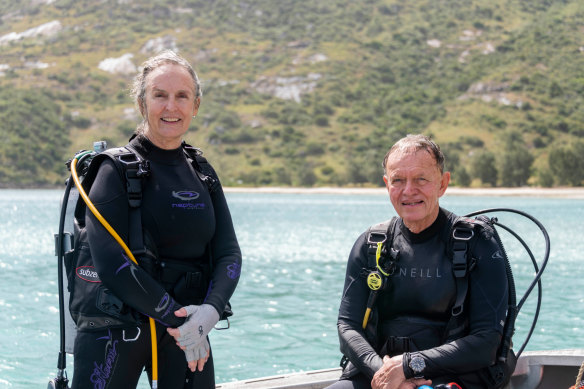
Anne Hoggett and Lyle Vail, based on Lizard Island, witness coral bleaching first-hand.
Meanwhile, every summer on Lizard Island has become a roll of the dice for the corals. Since 2020, bleaching has occurred annually (a frequency that Ove Hoegh-Guldberg, an Australian pioneer of coral bleaching research, thought would start around 2050). Bleaching is not a death sentence for corals: if a storm arrives or clouds roll in, the cooling can allow the animals to repopulate themselves with algae that might be living in the water and sediment, or from a little bit left in their cells. In the bleaching since 2020, the “dumb luck” of a last-minute weather change saved corals from dying. But in the last summer this luck ran out, says Hoggett, with up to 80 per cent of the important Acropora corals on the reef dying.
But the severe marine heatwave of early 2024 was not remarkable for what happened in Hoggett’s part of the reef, the north. (Coral Sea temperatures in 2017, 2020 and 2024 were the highest for 400 years, according to recently released University of Wollongong research.) It was the first time the south had been hit with unprecedented heat stress and bleaching. The heatwave was driven by a record-breaking global spike in temperatures that alarmed climate scientists, even when they factored in an El Niño and rising emissions (they’re not sure whether it’s a blip or a new normal).
In April, America’s National Oceanic and Atmospheric Administration (NOAA) declared the fourth global coral bleaching event. In Thailand, widespread bleaching prompted authorities to shut down whole islands to snorkelling tourists, and in Florida, underwater nurseries growing new coral were moved to deeper, cooler waters, while 1500 specimens were taken out of the sea and housed in tanks on dry land.
Wachenfeld says that while the latest reef snapshot, released earlier this month, showed record hard cover in two regions, the surveys were mostly conducted before last summer’s bleaching event. Also, he warns that the reef is generally more fragile because the fast-growing corals that first came back are less heat-tolerant, break easily in storms and are favoured by the predator crown-of-thorns starfish. Coral cover has always been up and down, says Wachenfeld, “but the downs and the ups have become more extreme in the last 15 years. The concern is that if we break the resilience of the system, at some point a down on the roller coaster will no longer be followed by an up.”
In another room of tanks at the simulator, Line Bay and I are looking at uniform rows of brown blobs. “Aren’t they wonderful?” says Bay, 53. They aren’t the most wonderful-looking corals I’ve seen, but I believe her when she says they’re part of an important trial.
‘Nobody wants to be the person who does the cane toad equivalent on a coral reef.’
AIMS’ executive director David Mead
This experiment, like many at the simulator, falls into the category of “assisted evolution”. Corals have evolved to live in some hot places – Magnetic Island corals, for example, can withstand 30.5 degrees for 20 days, while that same heat would make corals bleach within a day just 90 kilometres south. The problem is that climate change is warming the water faster than corals can adapt. With assisted evolution, scientists are speeding up this process, and one way they do this is to find coral parents that are more heat-tolerant. “Corals inherit heat tolerance from their parents; it’s like tall parents tend to have tall babies,” says Bay. So scientists might go to a bleached reef and pick the survivors for further breeding. They might go to a reef, take a coral sample and subject it to a heat test on the boat. Then they breed more of the corals that passed the heat test and return them to the reef.
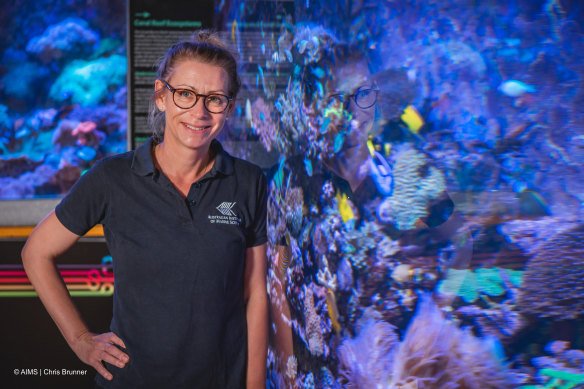
AIMS’ Line Bay has gene-edited corals.Credit: © AIMS | Chris Brunner
In the simulator, they’ve bred corals that have evolved to survive in hotter parts of the reef with corals from cooler parts, but this has had mixed success. They’ve also been interbreeding coral within the same species, which happens in the wild. But these are only allowed out of the lab in a controlled way – they’re brought into the simulator to spawn, then put back on the reef – just in case the hybridisation has caused a problem. (“Nobody wants to be the person who does the cane toad equivalent on a coral reef,” says engineer David Mead, a co-founder of RRAP and AIMS’ executive director.)
Bay, a genetic specialist, has also been working on corals using the gene-editing technology CRISPR-Cas9. But while there have been some encouraging early results, anything to do with manipulating genes in a coral is going to be tricky because heat tolerance is thought to be polygenic (more than one coral gene is responsible for it).
‘Are we playing God? I don’t think so. These are natural corals and natural processes.’
Line Bay
The most promising experiment is the one before us, with the “wonderful” brown blobs. AIMS scientist and University of Melbourne professor Madeleine van Oppen has discovered that a big factor in heat tolerance is the type of algae that lives inside it. In other words, whether your plant housemate can stand the heat can trump how heat-loving your parents are. There are two important groups of algae available for the most common corals and the one that’s more heat-resistant makes the coral grow slower. To overcome this problem, van Oppen and colleague Matthew Nitschke took the faster-growing algae type and heated it up in experiments. They bred the survivors, heated them again and repeated this over hundreds of quick-turnover generations across two years to fast-track their evolution. Then they injected this heat-tolerant algae into the tanks for the coral to take up.
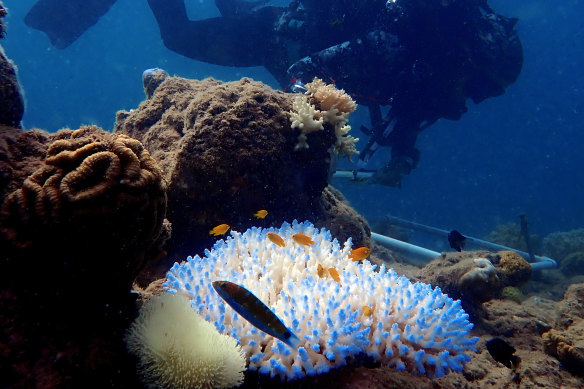
Bleaching coral. In the foreground, a fluorescing coral attempts to save its algae just before it bleaches by coating itself with a bright sunscreen. Credit: Dr George Roff
The corals have proven to be more heat-tolerant – but as with all these methods, there are questions RRAP needs answered before its planned large-scale deployment of more heat-tolerant coral next year. Will they reduce the genetic diversity of the reef? Will, for example, the heat tolerance stick in the wild, particularly when the experimentally altered coral breed with locals? Will the polyps just expel the heat-resistant algae and pick up another one? Will these corals be as fit? Will they be, for example, more prone to disease?
“A lot of biologists might not be comfortable with this mix of biology and technology,” says Bay. “Sometimes we get asked whether we’re meddling with nature. But the reason we’re doing this is because we’ve already meddled with nature. Are we playing God? I don’t think so. These are natural corals and natural processes.”
Last year, Terry Hughes, a professor of marine biology at James Cook University and one of Australia’s leading coral reef scientists, co-authored a research paper benignly called Principles for coral reef restoration in the Anthropocene. It was not benign. It was a full take-down of all the RRAP-like attempts to help the reef. The paper said some restoration projects have been exaggerated and such efforts would prove prohibitively expensive, logistically impossible at scale and likely detract from the main business of cutting carbon pollution. (This latter point particularly worries Lizard Island’s Anne Hoggett: “People look at media reports on reef restoration, and they think, ‘Those clever scientists are fixing this, I don’t have to worry about it.’ But it’s really just highly experimental and, frankly, unlikely to ever work.“) Meanwhile, assisted evolution, the paper said, might reduce coral fitness and was untested in the wild. Some hybrids, the paper said, could prove to be “mule-like genetic dead ends”. The only slightly positive conclusion the paper made was that small-scale coral restoration might be feasible for high-value tourist sites.
Hughes, who declined to be interviewed for this piece, is not alone in his scepticism about coral restoration and adaptation measures. The two other giants of Australian reef science – Charlie Veron, the so-called “godfather of coral”, and Ove Hoegh-Guldberg are also sceptical, but there’s an important distinction to be made. Veron and Hoegh-Guldberg support the sort of work being done by RRAP to develop more heat-tolerant corals, but have little time for other aspects of reef restoration. These include a multitude of projects rolled out across the world since the 1980s, some to address climate change, others to repair blast fishing and boat damage – watery farms of corals often grown on metal bars or suspended ropes; electric cables running from beach to reef to stimulate coral growth; giant concrete sculptures plonked on the seafloor as coral habitat; even shade cloth.
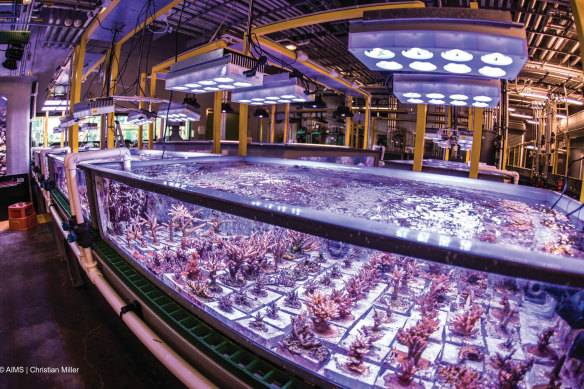
Sea simulator research into the “assisted evolution” of coral to aid heat tolerance.Credit: © AIMS | Christian Miller
Veron considers many such projects pointless. The one he hates the most is reef balls, which are large, bell-shaped concrete structures with holes in them. The Reef Ball Foundation says it’s placed a million balls on the sea floor of 89 nations. “It’s just rubbish that’s been put over the reefs of the world,” says Veron, who is turning 80 soon and is very cranky about all this. More broadly, he’s calling on scientists and governments to stop putting out corals that aren’t heat-adapted. “They will just die again,” he says. Twenty years ago, he would have “gone off the deep end” at the thought of scientists modifying wild corals and dispersing them on the reef. Now he thinks there’s no choice. “We’ve got to put modified corals out there. That’s the only path to getting through the years ahead.”
As Australian RRAP scientists prepare to disperse their more heat-tolerant corals over the reef, the question is, though: “Will they be heat-tolerant enough?”
David Mead, 56, is the kind of person you’d expect could solve any problem. An engineer from New Zealand, he started in mining research for BHP, led the engineering at Snowy Hydro, then applied for the job as second-in-charge at AIMS in 2006. He’s the brains and drive behind the National Sea Simulator and the person thinking about how to scale the lab findings to something that works on the reef. When he first came to the institute, he couldn’t quite believe the poor equipment the scientists were using. “It was Flintstones sort of stuff,” he says. They were doing these experiments without being able to properly control temperature, light or salinity.” So he fixed that – to the extent that Loni Koukoumaftsis’ corals think they’re living on a reef near Palm Island.
In 2018, Mead, the institute’s then chief executive Paul Hardisty and other research partners put an R&D proposal to the federal government. Driven by the catastrophic bleaching events of 2016 and 2017, they felt the reef needed a plan that went beyond the conventional (and still important) elements of eradicating crown-of-thorns starfish and improving water quality. But the cost, says Hardisty in his recent book In Hot Water: Inside the Battle to Save the Great Barrier Reef, was “staggering”. When they presented the sum – about $500 million over 10 years – department officials “went pale”, writes Hardisty.
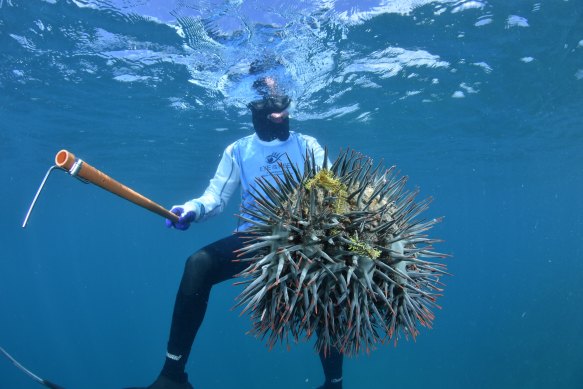
The crown-of-thorns starfish, one of the threats to the Great Barrier Reef.Credit: Commonwealth of Australia Reef Authority
He’d almost given up on the money until one day in April 2018 when a government official called, saying he’d get everything he asked for. Hardisty could barely believe it. But there was a hitch. The $443 million – which included a first-tranche of $100 million for RRAP – would go through the GBRF. The transfer of such a large sum of taxpayer funds to a small Brisbane-based charity – a decision made by then prime minister Malcolm Turnbull – was hugely controversial and even Hardisty admits it tainted its efforts. But now, six years later, the funding has been dispersed, and while the likes of Charlie Veron remain critics of the foundation, Hardisty and Mead say it turned out fine. (In May 2021, the Australian National Audit Office found the foundation had mostly used appropriate ways to deliver the money to partners.)
RRAP began by assessing several dozen ideas and whittling them down to six. “We had a no-crazy-ideas policy for a while there,” says Mead. One that made it through was cloud brightening, in which giant cannons, like those that make artificial snow, shoot nanoparticles of saltwater aerosols into the sky to make clouds more opaque, reflecting more sunlight and reducing light levels to limit bleaching. Mead says trials by Southern Cross University have proven you can create cloud-changing aerosols, but in their current form the guns use too much energy and the process is costly: he estimates $500 million annually to do the whole reef. Mead agrees people will be wary of how cloud brightening could affect the weather – further testing will examine the impact – and the idea of 500 to 1000 saltwater guns stationed along the coast. He nevertheless believes it could be a game-changer. “It’s the only idea on the table that might give you a protective window from the mid-2030s for about 20 years or so and would allow other adaptation measures to take hold.”
Alongside the RRAP research, there’s a big push for “coral rescue”. North American scientists, facing a grimmer situation, have advised Australian scientists to start now with a rescue program as an insurance policy. Mead says he and others are working on a funding proposal to move corals – about 10,000 wild colonies of the best brood stock – into slightly cooler waters. Separately, in Cairns, scientist Dean Miller is working with Charlie Veron on a coral “bank” for the reef’s 415 species. Miller and The Forever Reef Project have collected 179 so far and are racing against time to collect the rest by 2026 (Veron believes 15 species are already extinct).
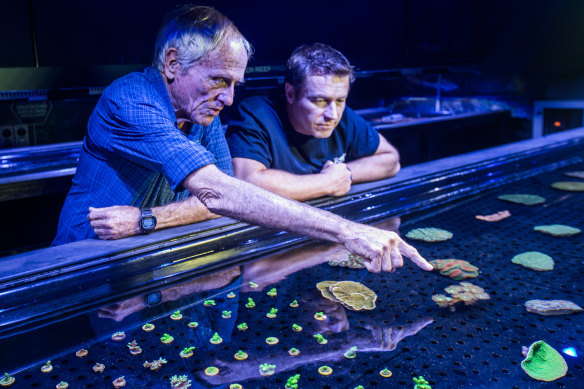
Charlie Veron (left) and Dean Miller at Cairns’ Living Coral Biobank, where the hope is to collect all 415 of the reef ’s species.Credit: Julia Sumerling / Great Barrier Reef Legacy
For RRAP, the big moment will be next year, when its pilot program starts by creating an extra half a million baby corals. “It’s really big compared to anything that’s happened anywhere on the planet,” says Mead. First, they must retrieve corals from the reef they’ve tagged as more heat-tolerant, or ones already placed there. On their annual spawning, these corals, about 30 centimetres across, then release their eggs and sperm into technology developed at AIMS called an Autospawner, which can create tens of millions of larvae.
The larvae will then settle on a piece of grey concrete that looks like a block of chocolate. These are then snapped apart and three tabs, each with 10 or so baby corals, are put into a ceramic seeding device. “And then you throw it literally over the side of the boat,” says Mead. He means this half-jokingly because there is some precision: the boat will have AI cameras that scan the sea floor for the best substrate for baby corals. (McLaren is designing two parts of this process: a machine that will snap the chocko blocks and insert them into the device, and something to automate the plonking-into-the-sea bit). Of the 30 baby corals on each seeding device, it is expected that one will live.
Some of the corals in next year’s inaugural deployment will be bred in the Autospawner from the more heat-tolerant survivors of bleaching events. Others, if approved by regulators, will contain laboratory-evolved algae. Half the baby corals will come from the harvesting of larval slicks, which are the long pink trails of embryonic larvae that float at sea after a mass spawning. Scientists scoop up the slick and put them in a floating pond with a mesh bottom. After the larvae develop further, they are released over the right location or settled onto a seeding device.
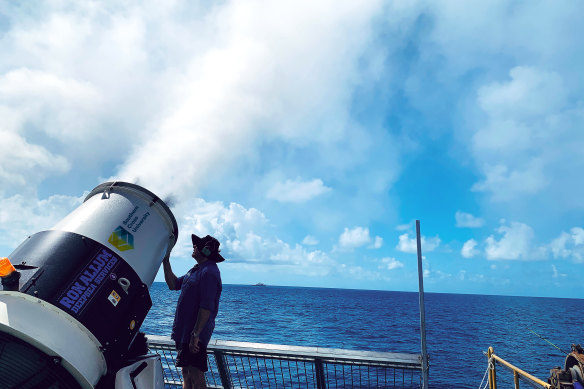
Cloud-brightening cannons, which spray seawater into the sky to create whiter clouds which reflect sunlight, could limit coral bleaching while other measures kick in.Credit: Southern Cross University
Because baby corals made from larval slicks have no scientifically measured heat advantage, this method is more about maintaining genetic diversity, as the lab-bred corals might survive the heat but be bad at other things, such as surviving disease. “It’s important to seed diversity and allow nature to select the best corals for the future,” says Bay.
Eventually, RRAP envisages this sort of process being run across the reef as a sort of mini-industry, creating jobs, particularly for traditional owners. “We want to put traditional owners on the front of that emerging industry,” says AIMS’ Indigenous partnerships team member Jordan Ivey, a Bundjalung man from northern NSW with South Sea Islander heritage.
Twenty years ago, when I first covered climate change’s threat to reefs, scientists would talk about corals’ heat tolerance in terms of increased temperature. Now they use a more sophisticated scale of heat stress called degree heating week (DHW) that measures how long the coral suffers elevated heat. If corals experience temperatures of one degree above the summer average maximum for one week, this is called a one DHW. If a coral sits in water two degrees above the summer average for one week, this is two DHW. Generally, corals will start to bleach at four DHW and die at eight. Last summer, the southern reef saw DHWs of 15.5 (the previous record was 13 in 2016). In the Caribbean last summer, they hit a remarkable 22 DHW.
The corals that RRAP scientists aim to disperse next year will have a marginal boost of withstanding three to five DHW. Bay and Mead admit it’s possible they will bleach and die at some point. But they can only put out what they’ve come up with and what regulators and traditional owners allow. It’s also not just about the heat tolerance, says Mead, it’s about testing how you distribute corals at scale and engage the people doing it. “This is ‘walk before you can run’ stuff,” says Mead. “Our modelling [of the future state of the reef] out to 2100 indicates that ideally, you’d be putting out 10- to 15-DHW corals into the system. So we’ve got a long way to go.”
Mead says RRAP’s success will depend largely on money. “Australia will have to prioritise some of its limited taxation revenue or the private sector will have to fund stuff. Unless we do that, we don’t go anywhere. And the cost of not doing anything will be so much more.”
Mead’s goal is to produce new corals for $1-$2 each (currently the cost is $10). If he had baby corals that could withstand 10-15 DHW, you could, he reckons, maintain 100 reef clusters or about 20 per cent of the reef (there are between 200 and 400 million corals in a reef cluster). But this would cost $200 million a year. Hard decisions then have to be made about which bits of the reef are helped. The ones tourists love off Port Douglas? The Whitsundays? “To put it rather crudely, we’re going to have to triage the other bits off and let them fend for themselves a bit more,” he says.
At some point, though, none of these things works with runaway climate change. Most of RRAP’s sophisticated models are based around the Intergovernmental Panel on Climate Change’s middle-of-the-road scenario of 2.7 degrees above pre-industrial levels by 2100 (the long-term temperature increase is about 1.3 degrees, though the last year broke all records, resulting in a 1.5 degree short-term increase). At 2.7 degrees, if all methods – cloud brightening, heat-tolerant corals, continued eradication of crown-of-thorns starfish – are employed, Mead says we have “a chance” of maintaining the values we love about the reef. With warming above that, less will be preserved, he says, and with unrestrained emissions, the corals will cook. “What exact path we face we don’t know, because the science and the forecasting is just not there.”
We end our tour of the simulator in Mead’s office. People’s expectations of what a “good” reef looks like will likely go down, he says. That’s partly why he requested a beautiful aquarium be built into the simulator’s main room, the same display tank that delighted the McLaren engineers when they visited last year. “That display tank is there to keep a baseline in [the researchers’] heads, because you get used to something being in a degraded state and slowly, through time, you start to accept it. That’s something we’ve got to guard against.”
Melissa Fyfe travelled to Hayman Island as part of a media trip funded by McLaren Racing.
To read more from Good Weekend magazine, visit our page at The Sydney Morning Herald, The Age and Brisbane Times.